| SD70 | SD70I |
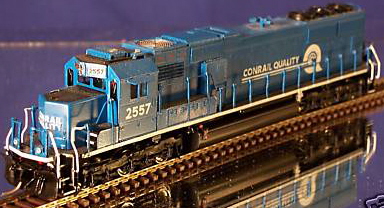 |  |
| SD70M | SD70ACe |
 | 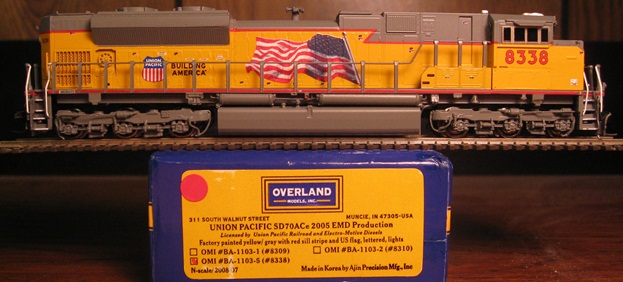 |
| SD75 | SD9043AC |
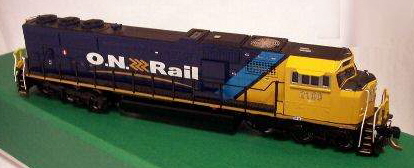 | 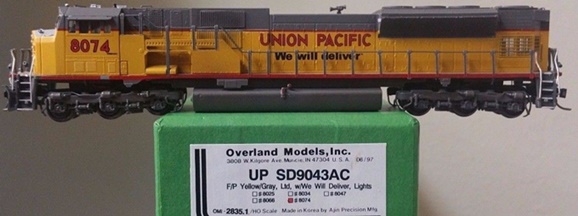 |
| SD70MAC | SD75M |
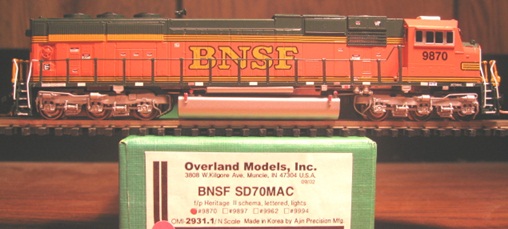 | 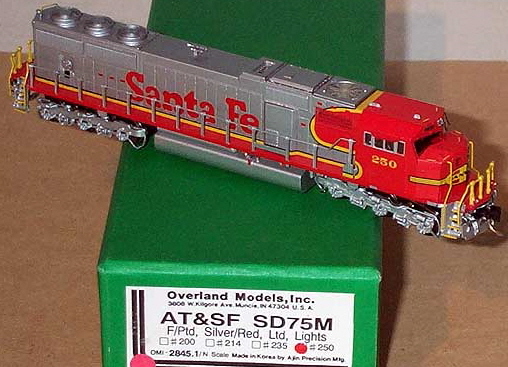 |
| SD80MAC | SD90AC |
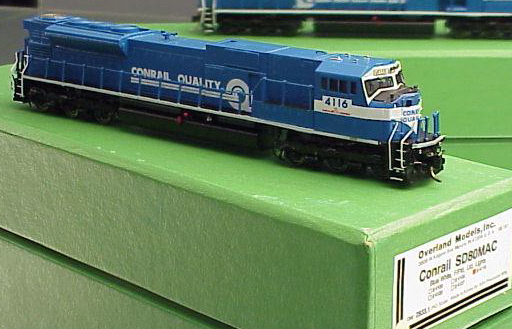 |  |
| SD90MAC | SD90MAC-H |
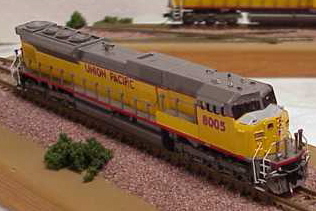 | 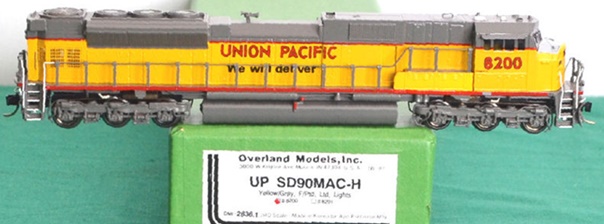 |
| SD70 | SD70I |
 |  |
| SD70M | SD70ACe |
 |  |
| SD75 | SD9043AC |
 |  |
| SD70MAC | SD75M |
 |  |
| SD80MAC | SD90AC |
 |  |
| SD90MAC | SD90MAC-H |
 |  |
Introduced: 1998 (first run), 2002 (second run) and 2008 (SD70ACe)
Six-axle EMD units have apparently been good sellers for Overland, as there have been several different releases over the years. The first (1998) run included SD70, SD70I, SD70MAC, SD70M, SD75M, SD80MAC, SD90MAC, SD9043AC, and SD90MAC-H models. The first version employs a typical "flat frame" Ajin mechanism. Catalog numbers are in the 2833-2851 range. The second (2002) run included SD70MAC, SD70M, SD75, SD80MAC, SD90AC, and SD90MAC models. Catalog numbers are in the 2930-2943 range. The second version employs an all-new split-frame / all-metal chassis. The 2008 release consisted solely of new SD70ACe models. Ajin reverted to the earlier "flat chassis" design with these. However, not exactly the same (but more on that shortly).
Note - the so-called Illinois Central SD70I models (2841.1) are actually SD70's (CN being the only road to ever actually roster SD70I's). So, despite what the boxes say, SD70I models were not actually part of the 1998 release.
The paint and detailing on all of these models is impressive. All sport body-mounted Micro-Trains couplers, window glass, and directional lighting (mounted inside the shell). All employ low-profile wheels, so no problems on Code-55 rails. None of them have traction tires.
As noted above, there have been three different chassis/mech designs. The first release employs a typical Ajin "flat" chassis -
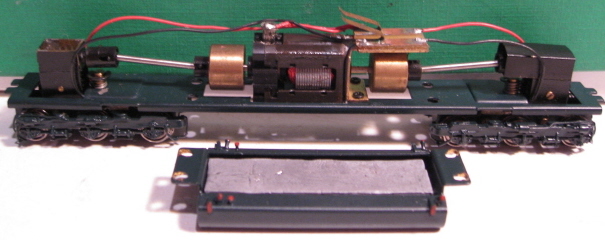
These first release models only have 8-wheel pickup (provided by wipers which contact the tops of all but the center wheels on each truck). These models (unfortunately) conduct current via wires running from the trucks up to a small PC board next to the 3-pole / skew-wound motor. Said PC board has metal strips which contact the aforementioned light board in the shell. Current is transferred from the PC board to the motor via more wires. All axles are geared and all the gearing is metal.
Despite the seemingly chintzy pick-up scheme, I can't really say that these models are poor performers. Far from it, actually. Yes, they do run just a bit noisier than six-axle Atlas/Kato (et al) diesels of similar vintage. But apart from the minor noise issue (which seems to be a general malady when it comes to brass), these are excellent running models. Pickup is fine, throttle response is smooth, and slow-speed creep is excellent. On the downside, these models are completely useless on narrow radius (9.75") curves - IE, instant derailment. Also, the 3-pole motor makes for a ridiculously high top-end speed. And yeah, I do have my reservations about their longterm viability (vis'a'vis all that wiring and the wheel wipers). But overall, I just can't argue with reality. The ones I've tried run great, look awesome and are, in general, excellent models.
To remove the shell, first remove the fuel tank (held on with four screws). Next, unscrew and remove the couplers. This will reveal two more screws that hold the shell to the chassis. Unscrew these and the shell should lift right off.
As you can see, the mechanism used in the second release is completely redesigned (and a real departure for Ajin) -

The chassis is all-metal and split-frame. Like the first version, the motor is an open-sided / skew-wound 3-poler. The sides of the chassis are coated with a thin layer of clear plastic to prevent shorting. The internal components are arranged very much like you'd find inside a typical Atlas or Kato diesel (dual flywheels, driveshafts, bearing blocks and worm gears all sandwiched between the two chassis halves). Two PC boards mounted inside the shell provide directional lighting (each with contacts that extend down to the chassis).
The trucks are completely redesigned as well, consisting of two electrically isolated metal halves. Gone are the wheel wipers and all the wiring, with current instead flowing from the wheels to the axles to the truck halves, and finally into the chassis halves. All axles are geared and all the gearing is plastic.
Performance on these second run models is very much similar to the first run locos (and in some ways, even better). Again, throttle response is smooth, pickup is perfect, slow speed creep is excellent and the top-end speed is a bit excessive. Overall, they run pretty quietly, but again, not quite as quietly as a comparable Atlas or Kato six-axle diesel. Given the new heft provided by the all-metal chassis, pulling power is strong. These second run SD's don't have the narrow radius curve derailing problems of the first run, however they do seem to prefer wider radius curves. Mine tends to slow down rather drastically when faced with 11" radius (or sharper) curves. However, I'm told that things will likely improve after the mechanism breaks in a bit. Overall though, these are exceptionally fine looking models that perform admirably. And given the improved mechanism design, will likely be easier to maintain and keep running.
The shells on these second release models simply pull off - no screws, no nothing (yay).
As noted above, the mechanism was redesigned yet again for the third (SD70ACe) release. And for reasons I can't quite fathom, Ajin decided to revert back to their old "flat chassis" design with this one -

The motor is a closed-sided Mashima (and as such, I have no idea what its internal characteristics might be vis'a'vis poles and winding). Pickup is provided by "stiff wire" wheel-back wipers contacting the outer four wheels on each truck (with wires then running from the trucks to a PC board mounted over the motor). The driveshafts and gear boxes are all new (as compared to the first version). All six axles are geared (with the gearing being a mixture of brass and plastic). Once again, sticky-uppy contacts on the upper PC board transfer current to the lightboard inside the shell.
I'm not sure if it's the new motor or the redesigned driveshafts / gear boxes, but these third-run models run considerably quieter than either of the previous two versions. Better still, they have zero problems navigating even the sharpest of curves (right down to 9.75"-radius). Overall, these are outstanding running models in every way, and every bit the equal of anything ever released by Kato or Atlas.
Shell removal on this third version is the same as with the first one (remove the couplers and then unscrew the two chassis screws).
Grade: A for all (although if you have narrow radius curves, "F" for the first release and "C" for the second)